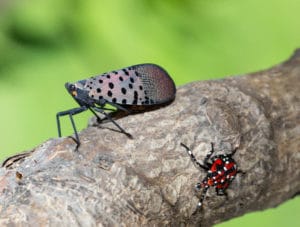
UPDATE
October 2019 – This paper has now been published in Gigascience.
Stop, Scrape, Squash… and Sequence!
The latest invasive insect to hit headlines, the spotted lanternfly, has a voracious, indiscriminate appetite, with a particular taste for apples, grapes and maple — bad news for the wine, orchard and syrup industries of New England, where the Asian pest has been spotted.
But there’s good news too, thanks to the expanded capacity of the new Sequel II System. USDA scientists were able to generate a high-quality, 2.3 Gb de novo assembly of a field-caught female Lycorma delicatula on a single SMRT Cell 8M.
Not only will the new genomic resource provide valuable insights into the little-known biology of the agricultural pest, which nearly wiped out entire vineyards in previous infestations, but such efficient assembly could enable the comprehensive genomic monitoring of the species throughout the field season, as well as rapid testing of pest intervention strategies.
This is important because the pest has the potential to cause devastation to several agricultural industries and communities. Shortly after the spotted lanternfly was detected in the U.S. in 2014 (believed to have hitched a ride on a shipment of stones), the Pennsylvania Department of Agriculture established a quarantine zone surrounding the site of first detection. Since that time, the L. delicatula quarantine zone has expanded from an area of 50 mi2 to over 9,400 mi2.
Despite this, essentially nothing is known at the genomic level about L. delicatula or any Fulgorid (planthopper) species.
As reported in a new bioRxiv preprint, a team of scientists from several USDA-ARS research laboratories, led by Scott M. Geib of the Daniel K Inouye U.S. Pacific Basin Agricultural Research Center in Hawaii and in collaboration with scientists at PacBio, sequenced and assembled the high-quality reference genome for the L. delicatula from a single library run on one PacBio SMRT Cell 8M. Previous planthopper genome projects required at least 100-5,000 inbred individuals and at least 16 different sequencing libraries, and despite the fact that the new USDA assembly is 2-4 times larger, it is 13-63 times more contiguous compared to those previous efforts.
“The methods described here for DNA extraction, library preparation and sequencing are straightforward and rapid, using established kits and leveraging the higher throughput of the Sequel II System to generate sufficient sequencing coverage with just one SMRT Cell and 30 hours of sequencing run time,” the authors write.
Accessible arthropods

The project also shows how such studies can now be achievable by individual labs rather than requiring large consortia that were typical of previous genome assembly efforts, the authors state.
“The ability to generate genomes de novo from field-collected arthropods makes high quality genomes accessible for many more species,” they added.
Rapidly generating foundational data for invasive species is one big advantage of performing single-insect genome assemblies, but there are others as well, the authors note.
Direct sequencing of wild specimens dispenses with the requirement of inbred lab colonies, which may take months or even years to establish, can be expensive to maintain, and are impractical or impossible for many species.
By sampling field-collected animals, genetic variation can also be more accurately characterized for local populations, without the risk of adaptation to lab culture or loss of heterozygosity.
And it is easier to assemble than a sample of many pooled individuals, each of which may contribute up to two unique haplotypes.
Bonus find
Although the scientists did their best to avoid sample contamination by bacterial symbionts known to reside inside the lanternfly, there were signs that the DNA of two endosymbionts were mixed into the insect DNA they extracted.
Rather than dismiss these fragments, the researchers decided to make the most of the finds, and identified two endosymbiont genomes within the assembly. This was relatively easy to do, thanks to the long reads and robust assembly strategy that allowed for clear discrimination of the microbial symbionts — which were each complete and in single contigs — from the host.
The complete genomes of the endosymbionts, Sulcia muelleri and Vidania fulgoroideae, may provide additional information that could prove useful for pest control, the authors state.
“Because obligate symbionts in phloem-feeding insects typically provide nutritional benefit to their hosts, the symbiont genomes offer insight into nutritional requirements and basic metabolic functioning of L. delicatula,” they write.
The bacteria could also present opportunities for pest control.
In spotted lanternflies, the endosymbionts are transferred from female to offspring through the ovaries, and there may be a time window during late summer feeding when this vital transfer could be disrupted. Or the bacteria could provide highly species-specific genomic targets for control with RNA inhibition (RNAi) strategies, the authors note.
May 6, 2019 | Plant + animal biology